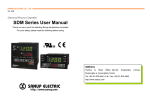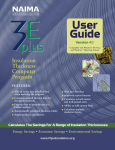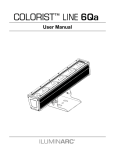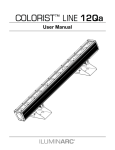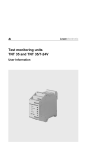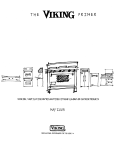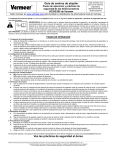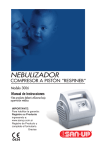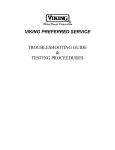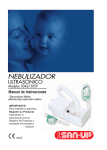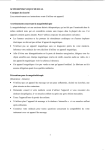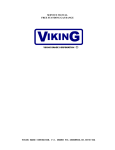Download USER MANUAL
Transcript
Vol. 0404E1 2004. 04. 15 Thyristor Power Regulators and Remote Controller USER MANUAL CONTENTS Caution for Your Safety 3 Warning and Caution General 5 Feature 5 Installations and Wiring 6 3-1. Installation Guidelines 3-2. Wiring Operating 9 4-1. Controller Description 4-1. Indicating 4-3. Changing Parameters 4-4. Parameters 4-5. Wiring and Operating According To Control Signal Remote Control 14 5-1. Wiring for Remote Controller 5-2. TPR 3E PLUS Parameter Setting Connected Remote Controller 5-3. Remote Controller Specification 18 6-1. Specification of TPR-3E PLUS 6-2. Specification of Remote Controller 6-3. Power Capacity and Fuse 2 ━━━━━━━━━━━━━ Caution for Your Safety ━━━━━━━━━━━━━━ Please keep these instructions and review before using this controller. This instruction manual uses WARNING and CAUTION as signal words for safety. WARNING WARNING indicates a potentially hazardous situation which, if not avoided, will result in death or serious injury. CAUTION CAUTION indicates a potentially hazardous situation which, if not avoided, will result in minor or moderate injury and at other times will result in death or serious injury. I may also be used to alert against unsafe practice. WARNING indicates a potentially hazardous situation which, if not avoided, will result in death or serious injury. 1. In case of using this unit with machineries (warehouse, medical equipments, vehicle, train, airplane, nuclear power or safety device etc.), it requires installing fail-safe device. • It may result in serious damage, fire or human injury. 2. Use a rated voltage to prevent damage or trouble. • It may result in fire. 3. Check the number of terminal when connect each line and signal input. • It may cause fire or trouble. 4. Do not turn on the power until the wiring completed. • It may cause electric shock. 5. Do not repair, wiring or checkup when electric power on. • It may cause electric shock. 6. Installation the controller where there is no dust, corrosive or explosive gas, direct ray of the sun, mechanical vibration or shock present. • It may cause fire or explosive. 7. This controller must be mounted on panel. • It may cause electric shock. 8. Do not repair beyond of authorized technician. • It may cause trouble. 3 CAUTION indicates a potentially hazardous situation which, if not avoided, will result in minor or moderate injury and at other times will result in death or serious injury. I may also be used to alert against unsafe practice. Installation Guidelines 1. Ensure the surrounding ambient operating temperature is between 0~50°C (32~122°F) • It may cause fire or wrong operation. 2. Altitude over 0~2000m use. 3. Ensure the power supply for the controller does not fluctuate greatly. Main supply voltage fluctuations not exceed ±10% of the normal voltage. • It may cause fire. 4. Install the controller where there is no dust, corrosive or explosive gas present. • It may cause fire. 5. Install the controller where there is no risk of mechanical vibration or shock. • It might shorten the life cycle of the product or give an electric shock. 6. This controller shall not be used outdoors. • It might shorten the life cycle of the product or give an electric shock. 7. When control signal wire connection, #20AWG (0.5mm2) should be used and screw blot on terminal block with 0.74N.m strength. • It may result in malfunction or error. 8. Keep the controller away from high current and voltage circuits. The controller and connection wires (esp. compensation conductors and RTD lead wires) should be kept approximately 30cm(12”) away from high current or voltage circuits to limit the possible affect of noise. • It may cause display fluctuation or error. 9. Do not use a place where temperature fluctuates or icing occurs. • It may cause fire, explosive or error. 10. In cleaning the controller, do not use water or an oil-based detergent. • It might cause an electric shock or fire that will result in damage to the product. 11. Do not inflow dust or dregs into inside of this controller. • It may cause fire or trouble. 12. Check the number of terminal when connect signal input line. • It may cause fire or trouble. 13. Installation category II 14. Pollution degree 2 4 1. General TPR 3E PLUS is up-graded from TPR 3E series with advanced digital technology. 기존의 TPR 3E Series가 보유한 장점들(안정된 회로, 출력보호, 경보기능)을 계승하여 신뢰 성 있는 운전이 보장되고 여기에 디지털기술이 추가되어 현장에서 요구되어진 다양한 요구 에 대응 할 수 있다. 2. Feature 1) Operation by analog (4-20mA) or digital (RS 485) input signals 2) Indicating of analog (4-20mA) signal and output current (line R or T) 3) Automatic output-limit cognition of external volume or internal limit setting 4) Various alarm mode (over current, line failed, Un-load, over-temp. load unbalance) 5) Relay alarm output 6) Programmable Soft start 7) Anti-fluctuation by input filtering function 8) Easy alarm confirm by built-in buzzer 9) Output current limit function 10) Built-in watchdog timer 11) RS-485 interface (MODBUS® protocol) (Optional) 12) Remote control function by Remote Controller (Optional) 13) Compact Size Note) TPR 3E PLUS can be replacement with TPR 3E and if you don’t use function, don’t need parameter setting. 5 3. Installations and Wiring 3.1 Installation Guidelines 1) Ensure the surrounding ambient operating temperature is between 0~50℃. 2) Ensure the power supply for the unit does not fluctuate greatly. 3) Install the unit where there is no dust, corrosive or explosive gas present. 4) Install the unit where there is no risk of mechanical vibration or shock. 5) Keep the unit away from susceptible instruments by high current and voltage circuits. The unit and connection wires (esp. medical instruments, controller and measurement instruments or computers) should be kept approximately 30cm (12”) away from susceptible instruments by high current and voltage circuits to limit the possible affects of noise. 3.2 Wiring 1) Power Prior to applying power, ensure the supply voltage is connected to the correct terminals as ordered specification or marked on the electrical connection diagram. Connect the power supply voltage to input line terminals. Tighten the power connections correctly. Poor tightening can lead to incorrect operation of the unit and can have serious consequences on the installation. All capacity is necessary to connect the power cables using round lugs. See table 1. Note) Keep the connection line does not shifting R, S and T. Table 1. Line Input, Output Terminals Symbol Description R Input of line R Operation Note Keep the connection line does not shifting S Input of line S T Input of line T Input power line 6 R, S and T. U Output of line R V Output of line S W Output of line T Output power line to load 2) Wiring for control signals The control signals terminals are located at the front left of the unit. They are used to connect: -the control signal 4~20mA and the run contact -the external V.R and the alarm output contact -the interface terminals and power supply Figure 1. Control signal terminal block Note 1) Keep isolated between control signal line and power line. Note 2) Ensure the power supply output voltage (+, -) for the remote controller does not shortage. Table 2. Control signal terminal Position 1 2 Name Assignment Control signal input (-) Control signal 4-20mA analog input. Input impedance is 250Ω. input (+) 7 Note 1. Supplement +12V power. 2. Suitableness for ON-OFF 3 REF control. 3. Suitableness for external V.R. Supplement current is 40mA max. input. Output enables or disable. 4 1. Suitableness for ON-OFF RUN control. 5 2. Suitableness emergency stop. 6 G1 7 G2 8 G3 Connecting external V.R., 1. Suitableness for output limit V. R.: 1kΩ 1W 2. A-type. Suitableness for non-signal control. 9 Alarm output Relay alarm contactor 250Vac 3A (R load) 1. RS-485 Interface Optional 2. Connect to remote controller MODBUS® Protocol 10 11 RS485 (-) 12 RS485 (+) 13 V cc - 14 V cc + Power supply for remote controller (+9VDC, 200mA) Input power Control signal terminal Output power 8 Optional 4. Operation 4.1 Controller Description 4.2 Indicating Upon connecting power the unit is in a state of automatic operation and the input signal or load current capacity is indicated on the front display. If press [ENT] Key more than 2 second change display to input signal and load current capacity R and T line. Top LED is control signal input sign. (Unit=%) Middle LED is load current capacity sign of line R. (Unit=A) Bottom LED is load current capacity sign of line T. (Unit=A) 4.3 Changing Parameters The set value can be changed by using [▲], [▼] and [ENT] key. 1) If press the [PAR] key, shift input signal to [PAS] for password input. 2) Pass value can be changed by using the increase[▲] and decrease[▼] key on displayed PAS display. 3) After changing the value of a password, the right decimal point blinks, indication 9 the parameter has not been accepted. 4) By pressing [ENT] key this value is accepted and entered into EEPROM (nonvolatile memory). When the accepted the decimal point disappears. Enter password to access parameters setting group. Password is “5”. Enter password to access interface parameters setting group. Password is “15”. 5) If pressing [PAR] key, can be select each parameters when entered pass value. 6) Set parameter value after select using parameter. 7) Once finished changing parameter values, pressing [PAR] key for more than 2 seconds returns the controller to normal operation and the process value will be displayed. Waiting approximately 80 seconds without pressing the key will return the meter to normal operation as well. 4.4 Parameters See table no. 3 for setting parameters. Table 3. No. Parameter list Symbol Setting Data Range Operation PASS Changeable display of 0 - Indicating input signal or load current by [ENT] key. 1 PASS number Disable 2 Output limit high 0~100% connected when external VR. 3 4 None Load current high Soft Start time limit 5~240A 1~250 sec. 10 If set to ‘0’ stop the function. 5 Operation 5 for ALm: Alarm only over OFF: Cut off output current limit alarm. Operation 6 for Cnt: Output control line ALm: Alarm only failed alarm. Operation 7 OFF: Cut off output for over ALm: Alarm only temperature alarm. OFF: Cut off output Input Filter 8 0~10 sec. Wait time for un-load 9 alarm. Operation for internal 10 buzzer. 11 Select input 12 Address for interface Delay 14 time interface 0~254 sec. OFF, ON Against for fluctuation If set to ‘0’ stop the function. OFF: Turn off On: Turn on Analog, AnA: Analog (4~20mA) Interface COm: Interface 0~31 RS 485 address 2400, 4800, RS 485 speed Speed for interface 13 5 15 9600bps for 1~4 Delay time for reply 4.5 Wiring and Operating According to Control Signal 1) 4~20mA Current Input Signal This is frequently used operation for control. Control signal is 4~20mA dc current. Maximum output voltage is limited by external V.R or OUt parameter value. Note 1) In case of connect external V.R, keep the terminals number. Note 2) If connect external V.R, at G1, G2, and G3 terminal, disable internal parameter OUt automatically. 11 Figure 2. Wiring for current input signal 2) ON-OFF Contact Input Signal Output will be un-continuous ON-OFF by dry contact signal. Maximum output voltage limit by output limit parameter [OUt] or external V.R. Figure 3. Wiring for contact input signal 12 3) Manual control by external V.R Output power will be control by turn angle of output limit V.R or output limit parameter (Symbol: OUt). Figure 4. Wiring for non-control input signal 4) RS 485 Interface (Optional) TPR-3E PLUS will be control by RS-485 interface signals. Apply power to the TPR-3EPLUS and go to parameter (Symbol: Smd). Set up the control signal input (Symbol: COm). Refer to the TPR-3E PLUS interface manual for instructions on using interface. Note) If control signal input selected interface, current signal control will be disable. 13 Figure 5. Control by RS 485 Interface 5. Remote Control (Optional) 원격지시조절기(Remote Controller) 를 사용하면 TPR의 통신기능을 이용하여 원거리 에서도 운전에 필요한 각 변수를 변경 할 수 있고 운전상태를 확인 할 수 있다. 또한 패널 외부의 암페어메타 기능을 수행할 수 있다. 5.1 Wiring for Remote Controller 1) Short distance installation In case of Install distance is less than 10m: Use main unit power. (Terminal Vcc) 2) Long distance installation In case of install distance is more than 10m till 1200m: Select remote controller power option. (90-240VAC, 50/60Hz) 14 Figure 7. Wiring Remote Controller 5.2 TPR-3E PLUS Parameter Setting Connected Remote Controller Table 5. Parameter Setting No. 11 Symbol Setting Data Select input 12 Address 13 Speed 14 Delay time Range Analog, COm 0~31 2400, 4800, 9600bps 1~4 15 Set Value Refer Description to set remote Controller for control PASS type 1 No. 1 96 9600bps 1 Default 15 5.3 Remote Controller All remote controller functions are almost same with main unit controller function except below. 1) Reset key function from front panel 2) Fixed interface parameters: Address; 1, Speed; 9600 BPS, Delay Time; 1 Figure 6. Front of Remote Controller Table 4. Remote Controller Parameter List No. Symbol Setting Data Range Operation PASS Changeable display of 0 - Indicating input signal or load current by [ENT] key. 1 PASS number Disable 2 Output limit high 0~100% connected when external VR. 3 4 None Load current high Soft start time limit 5~240A 1~250 sec. 16 If set to ‘0’ stop the function. 5 5 6 7 Operation for ALm: Alarm only over OFF: Cut off output current limit high Operation for Cnt: Output control line ALm: Alarm only failed Operation OFF: Cut off output for over ALm: Alarm only temp. OFF: Cut off output 8 Input filter 0~10 sec. 9 Wait time for un-load 0~254 sec. 10 Operation for internal buzzer 11 Remote set value 12 Select input 5 OFF, ON Against for fluctuation If set to ‘0’ stop the function. OFF: Disable On: Enable 0~100% Analog, AnA:Analog (4~20mA) COm COm: Interface 15 Note) If set to the ‘Com’ on parameter no 12, TPR output will control by the remote set value of parameter no. 11. 17 6. Specification 6.1 Specification of TPR 3E PLUS Voltage: One of AC 220V, 380V, 440V (AC 100V, 110V, 120V, 200V, 240V, 400V are made by order) . ±10% Cycle: 50/60Hz Current capacity: 35A, 50A, 80A, 100A, 120A, 150A, 190A, 240A, 500A. (in case of ambient temperature is 50℃ or less) Control Mode: Phase angle Input Signal: DC4~20mA (Input impedance 250Ω), ON-OFF dry contact, Non-signal (1kΩ VR), Interface (RS485 MODBUS Protocol) Output: Maximum 97% of input voltage Load: All resistance loads. Primary of transformer Interface Protocol: RS 485. MODBUS® Operating Temperature: 0~50℃ Cooling: Under 100A: Natural Cooling Above 120A: Fan Alarms: Over Current, Partial Line Failure, Load Unbalance, Unload, Thyristor Overheating. Alarm Output: AC 250V 1A (R Load) Insulation Test: Between Power Terminal and Case AC 500V 50MΩ or more Puncher Test: Between power terminal and case AC 2000V. 1 min. Dimension: 35A, 50A – 190(W) X 280(H) X 190(D) (mm) 80A, 100A - 240(W) X 350(H) X 240(D) (mm) 120A~240A - 300(W) X 350(H) X 240(D) (mm) 6.2 Specification of Remote Controller Input: Direct communication with TPR-3E PLUS (Fixed Address 1, Speed 9600bps, Delay Time 1) Max. Install Distance: In case of using main unit power; 10m or less In case of built-in power board; 1200m max. (Optional) Display Parameter: Input signal (%), R and T Φ output current (A) Dimension: 96(W) X 48(H) X 100(D) (mm) 18 6.3 Power capacity and fuse model (Note. cosθ =1) Power Capacity and used fuse Ampere Model 220V (A) kw TPR 3E PLUS 380V Fuse kw Fuse 440V kw Fuse 35 13 JR 31-40 23 JR 61-40 26 JR 61-40 50 19 JR 31-60 32 JR 61-60 38 JR 61-60 80 30 JR 32-100 52 JR 62-100 60 JR 62-100 100 38 JR 32-120 65 JR 62-120 76 JR 62-120 120 45 JR 32-150 78 JR 63-150 91 JR 63-150 150 57 JR 33-180 98 JR 63-180 114 JR 63-180 190 72 JR 36-200 125 JR 66-200 144 JR 66-200 240 91 JR 36-250 157 JR 66-250 182 JR 66-250 Note 1) Use only rapid fuse for semiconductor. Note 2) Exhortation capacity is 60% or less than of maximum capacity. Note 3) Equation three phase power: P(kw) = √3 X V X I X cosθ Note) This manual is subject to change without notice. SANUP ELECTRIC CO. Headquarter and Factory: 240-42, Euijeongbu 2 dong Euijeongbusi Kyoungkido, Korea Tel. 0082-31-876-4641~3 Fax. 0082-31-876-4640 Seoul Office 1: 42, Jangsa dong Jongrogu Seoul, Korea Tel. 0082-2-2265-2298, 2272-0785 Fax. 0082-2-2272-9450 Seoul Office 2: Ga-1612, Central Distribution Center Gurodong Gurogu Seoul, Korea Tel. 0082-2-2689-0648, 0658 Fax. 082-2-2689-0043 http://www.sanup.com email: [email protected] 19



















